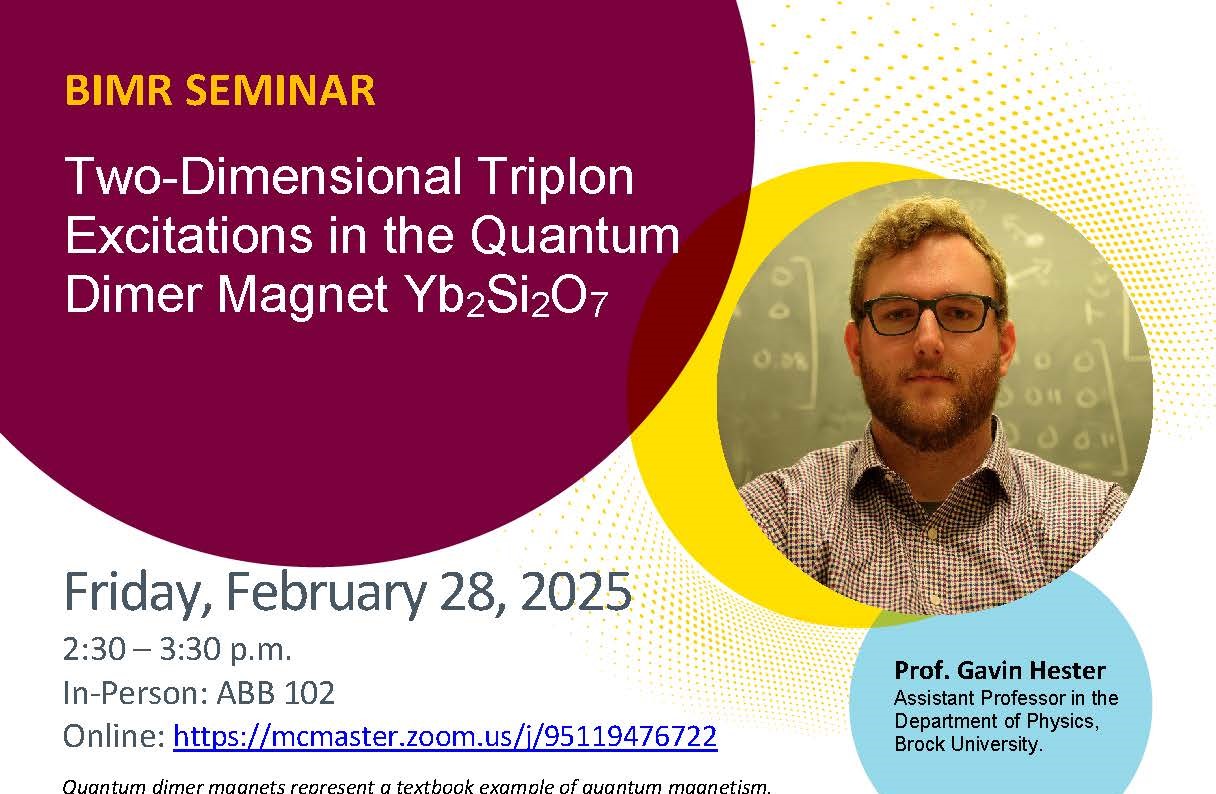Two-Dimensional Triplon Excitations in the Quantum Dimer Magnet Yb2Si2O7
Feb 28, 2025
2:30PM to 3:30PM

Date/Time
Date(s) - 28/02/2025
2:30 pm - 3:30 pm
Categories
Prof. Gavin Hester
Assistant Professor in the Department of Physics, Brock University
Quantum dimer magnets represent a textbook example of quantum magnetism, where nearest-neighbor spins entangle to form spin singlets (dimers). The excitations of the quantum dimer magnet are a triplet of Stot = 1 states, referred to as triplons. An applied magnetic field causes the lowest energy triplet state (Sz = 1) to be driven to degeneracy with the singlet ground state, resulting in Bose-Einstein condensation (BEC) of the triplons. Typically, the magnetic field induced BEC state for quantum dimer magnets presents as a symmetric dome in the field vs. temperature phase diagram and the system can be effectively mapped to a BEC of triplons in the vicinity of the transitions into and out of the dome.
In this talk, I will discuss Yb2Si2O7 which exhibits a monoclinic lattice that forms distorted honeycomb layers of magnetic Yb3+ ions that eludes magnetic order down to 50 mK, entering a quantum dimer magnet state. In Yb2Si2O7, an asymmetric dome was observed in the phase diagram for fields applied along the c-axis and the critical fields to enter the BEC are significantly smaller than those of other quantum dimer systems. This is the first evidence for BEC in a rare-earth based quantum dimer magnet system. Theoretical explanations of the asymmetric dome in the phase diagram have disagreed, particularly focusing on possible anisotropy in the exchange interactions and g-tensor. Here I will present our inelastic neutron scattering measurements and analysis for a field applied along the b-axis that aim to quantify the strength and anisotropy of the magnetic exchange interactions. We have combined multiple measurements of the field polarized spinwaves along different crystallographic directions and linear spinwave theory to fit the magnetic exchange interactions in Yb2Si2O7. These fits provide strong evidence that the magnetic exchange is predominantly Heisenberg-like and that the triplons are confined to the honeycomb layers. This provides promise that Yb2Si2O7 can be an intriguing playground for exploring BEC physics and further develop our understanding of the quantum phases possible with rare-earth ions.
Biography:
Gavin Hester is an Assistant Professor in the Department of Physics at Brock University. He joined Brock University in 2023, following a postdoctoral researcher position at Purdue University under the supervision of Prof. Arnab Banerjee and Prof. Yong Chen. He received his PhD. from Colorado State University in 2021 while working with Prof. Kate Ross. His research focuses on the study of quantum magnetic materials using a wide variety of neutron scattering techniques. Recently, his research has centered on the search for quantum magnetic states in amorphous materials.
In-Person: ABB 102
Online: https://mcmaster.zoom.us/j/95119476722
Meeting ID: 951 1947 6722
Passcode: 475525

